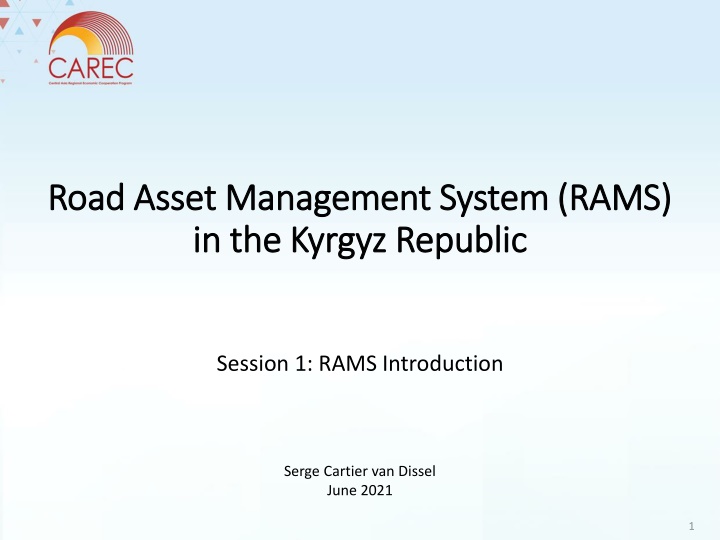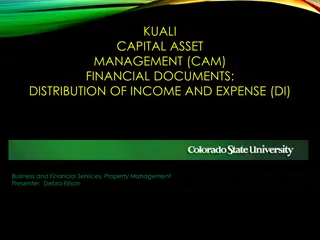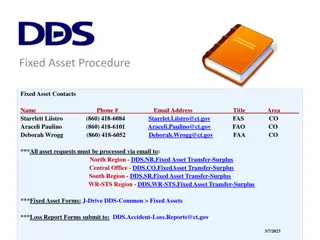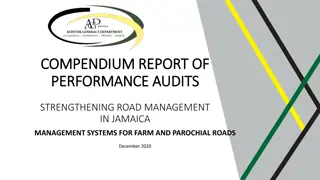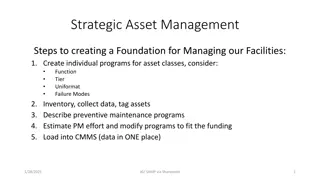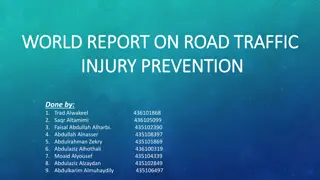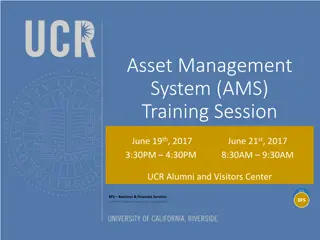Road Asset Management System (RAMS) in Kyrgyz Republic - Introduction and Development
The Road Asset Management System (RAMS) in the Kyrgyz Republic is introduced to optimize road funding allocation and network maintenance needs. The system helps in data collection, analysis, and budget allocation for road planning, ensuring efficient road management. RAMS aids in identifying treatment approaches, prioritizing tasks, and predicting future road conditions and costs. Integrating RAMS into annual planning, budgeting procedures, and developing domestic capacity are essential for its successful operation.
Download Presentation

Please find below an Image/Link to download the presentation.
The content on the website is provided AS IS for your information and personal use only. It may not be sold, licensed, or shared on other websites without obtaining consent from the author.If you encounter any issues during the download, it is possible that the publisher has removed the file from their server.
You are allowed to download the files provided on this website for personal or commercial use, subject to the condition that they are used lawfully. All files are the property of their respective owners.
The content on the website is provided AS IS for your information and personal use only. It may not be sold, licensed, or shared on other websites without obtaining consent from the author.
E N D
Presentation Transcript
Road Asset Management System (RAMS) Road Asset Management System (RAMS) in the Kyrgyz Republic in the Kyrgyz Republic Session 1: RAMS Introduction Serge Cartier van Dissel June 2021 1
Agenda Agenda Meeting Agenda 1. RAMS introduction What is the function of a RAMS How does a RAMS fit into the wider context of road management What are the phases of RAMS development How does Kyrgyz Republic compare to other CAREC countries 2. RAMS development What data has been collected in the Kyrgyz Republic What is the functionality of the database How is the collected data used for selecting and prioritizing treatments What remains to be done for the RAMS development 3. RAMS integration How to ensure an appropriate institutional framework for RAMS operation How to integrate the RAMS into annual planning and budgeting procedures What funding levels are required for the road sector and how can these be financed How can we develop domestic capacity to implement the planned works 2
Road Asset Management System Road Asset Management System Any system that is used to collect, manage and analyse road data for road planning and programming purposes Purpose: Optimizing the level and the allocation of road funding in relation to medium- and long-term results regarding road conditions and road user costs Define the road network maintenance, repair and improvement needs Based on inventory, condition and traffic data Determine the required budget to address those needs Determine how the available budget is best allocated To different roads and networks (class, traffic, etc.) To different treatment types (maintenance, current repair, mid-term repair, capital repair) Based on agreed prioritization criteria Economic (e.g. road user costs, traffic levels) Social (e.g. population, minimum access) Predict the impact of that budget allocation On future road network conditions On future maintenance and repair costs Monitor the road network over time 3
Network vs Project Planning Network vs Project Planning RAMS is a network planning tool Limited data for all roads Planning for an entire (sub-)network Based on data collected for entire (sub-)network Identify best treatment approaches Determine budget needs and propose budget allocations Limited data collection to reduce costs Different from project level planning Detailed data for some roads For specific road (section) Much higher data requirement Support preparation of designs Determine volumes of works 4
Benefits of a RAMS Benefits of a RAMS Allows objective identification of all treatment needs and costs Identification of needs and future timing of treatments Traditional planning generally shows only part of treatment needs Traditional planning is generally more subjective and difficult to verify Allows allocation of the available budget to be optimized Optimize impact on reducing road user costs (costs to the economy) Optimize impact on future road network conditions Traditional planning is often suboptimal focus on fixing defects rather than preventing them Provides basis for determining suitable budget levels Show the impact of different budget levels of future network conditions and road user costs (cost to the economy) Provides proper basis for negotiations on budget levels 5
Costs of a RAMS Costs of a RAMS Collection of network data Annual collection of data for part of the network Cost depends on data types to be collected and collection frequency Survey equipment procurement/replacement and annual operation RAMS database operation and data analysis Small team of dedicated staff involved in database operation and data analysis Resources for operation of the RAMS equipment and software Costs of the RAMS more than compensated by increased efficiency in the use of the road sector budget Long-term savings in budget needs for the road network 6
Road Asset Management System Road Asset Management System RAMS database Data collection Data analysis Survey equipment Planning module Data management Reporting 7
Road Asset Management System Road Asset Management System Data collection Road data (inventory, condition, traffic, other) Treatment data (costs, performance, etc.) Missing / outdated data makes a RAMS useless Data management (database) Store data and make it easily accessible Combine different data sets Prepare reports - provide statistics for the network Data analysis (planning tool) Identify required budget Criteria for prioritization + allocation of specific budget Algorithms for predicting future road deterioration and user costs May incorporate other modules Bridge or tunnel management system Contract management system Data collection Data management Data analysis 8
RAMS Integration RAMS Integration Institutional framework Resources for RAMS operation Procedures for RAMS operation Especially data collection Planning and budgeting procedures RAMS integration into planning systems In time for budget preparation Used as basis for budget preparation Financing procedures Influence budget levels by predicting impact on future network conditions Identify alternative financing options Implementation modalities Capacity to implement planned works Shift towards mid-term repair Suitable contracting modalities Institutional Framework Planning Data collection Data management Data analysis Financing Implementation 9
RAMS development phases RAMS development phases Phase 1: Piloting Data collection for small part of the network Simple (temporary) database for data storage with limited functionality Data analysis using commercial software (RONET, HDM4) Often carried out by consultants Phase 2: Development Data collection for entire road network Proper RAMS database with extended functionality Data analysis through integrated planning module or external software Often carried out by government (outsourced) with project consultant support Phase 3: Integration Institutional framework established for RAMS operation RAMS forms the basis for annual and multiannual planning and budgeting Budget levels and allocations influenced by RAMS analysis of needs and priorities Domestic implementation capacity responds to new priorities (mid-term repair) 10
RAMS status in the CAREC Region RAMS status in the CAREC Region Phase 3: Integration Phase 2: Development Phase 1: Piloting AFG AZE PRC GEO KAZ KGZ MON PAK TAJ TKM UZB AFG AZE PRC GEO KAZ KGZ MON PAK TAJ TKM UZB Inter- mittent Partial Network Being prepared Being prepared Inter- mittent Inter- mittent Partial Network Inter- mittent Partial Network Inter- mittent Partial Network Annual, outsourced Inter- mittent Partial Network Being prepared Being prepared Data collection frequency Annual Annual Starting Starting Partial Network Being prepared Being prepared Partial Network Limited scope Data collection extent Network Network Network Network Database Yes Yes Yes Yes Yes Not used Yes Most provinces Inter- mittent Being prepared Being prepared Data analysis HDM4 Not used HDM4 - RAMS unit Yes Yes Yes Yes Yes Yes Yes Yes Yes - - RAMS influencing planning RAMS influencing financing Some provinces Inter- mittent - Yes - - - Yes - - - - - - Yes - - - Yes - - - 11
